|
|
|
Published
on 8
Jun 2008
|
All rights reserved.
|
|

|
"Just watch out how much of this
unrealistic proportion could make into production", I thought.
|
Seeing
the reborn Scirocco, I can't help sighing how long we have been missing
an affordable Volkswagen coupe !
Volkswagen made two generations of Scirocco - Mk1 from 1974 and Mk2
from 1982 - between them some 800,000 units were produced. Following
them was Corrado, a great handling coupe that we loved but
unfortunately the public didn't. Volkswagen killed it in 1995 without
designating a successor, since then for a decade the German giant car
maker did not have any coupes shown on its price lists. What a shame !
Two years ago, Wolfsburg showed a concept car called "IROC", a name
extracted from SCIROCCO. Its purpose
couldn't be clearer, that is, to pave the road for the resurrected
Scirocco. Depending on your preference, you may call it an aggressive
interpretation of hot hatch or a "shooting brake coupe". Volkswagen
apparently preferred the latter. It insisted the car was a coupe
instead of hot hatch, because otherwise it would be meaningless to sell
the car alongside Golf GTI, which provides the mechanical basis for
IROC.

|
The production car lost 80 percent of
the emotion of IROC...
|
I remember at that moment I wasn't too
convinced with the
concept. In my understanding, a coupe should not have a vertical
tailgate. This simply works against my classical school sense of
beauty. Nevertheless, apart from the wrong tail, the design,
responsible
by then VW design boss Murat Gunak, was quite striking. It had a coke
bottle shape body, very wide fenders, huge wheels and the front slope
looked very fast. Just watch out how much of this unrealistic
proportion could make into production, I thought.
Unfortunately, during the productionisation process the Scirocco really
lost much of that sexy proportion. Even worse, Murak Gunak left
Volkswagen due to a big management shake up. The new styling team of
Walter de Silva scrapped the radical front mask of IROC and adopted a
very conservative design instead. The rear lights design are equally
conventional. Now the production car lost 80 percent of the emotion of
the concept car and went back to the typical Volkswagen group style.
In other words, German elegance and restraint.
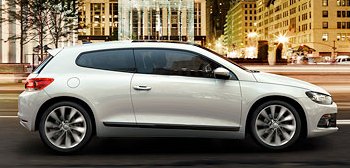
|
Slimmer windows and kick-up rear side
windows have some sporting pretensions, though still not enough to
offset the vertical hatchback...
|
Nevertheless, under natural sunlight
the Scirocco still has more road presence than your regular Golf GTI.
Being 66 mm lower yet 50 mm wider, it has stronger sense of speed and
roadholding. The slimmer windows and kick-up rear side windows have
some sporting pretensions, though still not enough to offset the
vertical hatchback. Most people will see it as a crossover between
hatchback and coupe, something like Opel Astra GTC.
Inside the cabin, the Scirocco feels more special. First, you drop into
a bucket seat which is mounted 10 mm lower than Golf GTI. Then you will
feel yourself closely enveloped by the low roof, high shoulder line and
thick C pillars as in an Audi TT. Visibility is much poorer than Golf,
but isn't it
exactly how a coupe should look like ? Facing you is a familiar quality
dashboard and console, this time come from Volkswagen Eos. It looks
smarter than that of Golf. At the back are two individual bucket seats.
They are not as spacious as in Golf, of course, but still offer decent
comfort for average size adults in short trips. Boot space is 60 liters
less than Golf.
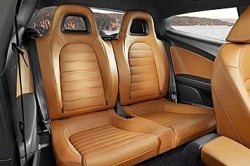 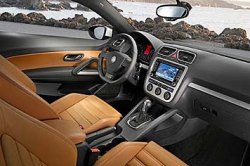 |
| Cabin feels enveloped around you... |
We seems to have spent too many words
on the design and
packaging of Scirocco. Never mind, its mechanical aspect is more
straightforward. Based on the PQ35 platform of Golf and shares its 2578
mm wheelbase, the Scirocco adopts the wider tracks of Passat CC. This,
together with a lower center of gravity and a stiffer steel monocoque,
should improve handling. The MacPherson struts and multi-link
suspensions employ stiffer springs, plus a standard electronic adaptive
damping to show its superiority over Golf. Control system offers 3
driver selectable modes (Comfort, Normal and Sport) to alter suspension
stiffness, throttle response and weighting of the electrical assisted
steering.
On the road, Scirocco displays a very matured ride and handling
combination. Its chassis feels rock solid. Ride is smooth and well
damped, a strong advantage over most affordable coupes. No matter
roadholding or body control, it feels superior to Golf GTI, giving the
driver higher confidence to attack corners. On the other side, the
Scirocco is still tuned to be safe and forgiving to handle. Push it
near its limit, it will understeer progressively to swing you back to
the safe side. Back off throttle mid-corner and it will tighten its
line a little, without any drama. As in Golf, the electrical power
steering is one of the best of its kind. While not as feelsome as a
good old hydraulic steering, it is accurate, free of torque steer and
the assistance builds up naturally.
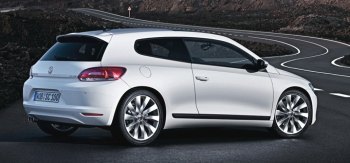
|
No matter roadholding or body control,
it feels superior to Golf GTI...
|
Powertrain is another strong card of
Scirocco. Initially
Volkswagen offers it with 3 direct injection turbocharged petrol
engines. At the top is the 200 horsepower 2.0TSI (previously known as
TFSI), familiar to the owners of Golf GTI. Smooth and flexible power
enables the Scirocco to sprint from 0-60 mph in 6.7 seconds. Flat out
it will top 145 mph. The other two engines are both 1.4-liter TSI, one
employs Twincharger (supercharger + turbocharger) for 160 horsepower
and another employs only a small turbo to deliver 122 hp. I love the
2.0TSI, but my heart always goes to the smaller forced induction
engines, not only because of my green standpoint but also because they
are lighter thus improve handling. No matter which engine, the driver
of Scirocco will be very happy.
Equally satisfying is the transmission choices - a slick 6-speed
manual, a 6-speed wet clutch DSG for the powerful 2.0TSI and a 7-speed
dry clutch new DSG for both 1.4TSI. No other car makers will serve
their
clients better in this aspect.
If you love Golf GTI like us, you will love Scirocco even more, because
it possesses all the good qualities of Golf GTI and pushes further in
ride and handling. However, if you are looking for a beautiful coupe
or the most exciting drive, Scirocco will not be the right answer.
After all, it is actually a hot hatch. |
Verdict:     |
| Published on 26
Nov
2009 |
All rights reserved.
|
|
Scirocco R
|
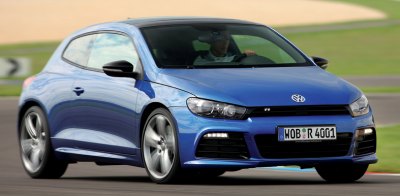
|
It might not be the ultimate hot
hatch, but it is definitely the most desirable until now...
|
Having
just fended off the challenge from Renault Sport Megane, Ford Focus RS
is facing another strong rival, Volkswagen Scirocco R. On paper, the
fast Ford has all the superior ingredients to beat the fast Volkswagen
- a bigger engine with one more cylinder and 40 more horsepower (not to
mention 66 lb-ft of extra torque), a genuine limited slip differential
and a torque-steer-countering front suspension geometry. However,
sometimes things are not as straightforward as calculation. Volkswagen
group has long been masterminding the art of hot hatches since the
first Golf GTi. In the following years, fast Golfs - let it be GTi,
G60, VR6 or R32 - consistently won our applauses. In particular, the Mk
V and Mk IV GTi remain as our favourite everyday hot hatches. However,
when it comes to challenge the fabulous Ford Focus RS, Scirocco R is
our first choice.
Why ? Although Volkswagen is also introducing a 4-wheel-drive Golf R at
the same time, I believe Scirocco R, with its lighter and more honest
FWD layout, plus the inherent benefits of its low center of gravity and
wide stance, should be the better driver's car. If you park Scirocco R
alongside Focus RS, you will see the Volkswagen looks much sportier in
profile. You sit low in its bucket seat as in a sports car, a sharp
contrast to the high-mounted, unsatisfying driving position of the
Ford. Visually, the Scirocco is also by far more desirable. Its
exterior is sporty yet understated, unlike the boy-racer Focus. Build
quality looks superior outside, and win by a million miles inside the
cabin. In short, if feels far more expensive than the Ford.
When you start their motors, you will notice Ford's Volvo-sourced 5-pot
engine has more noticeable turbo lag at the bottom end. When it starts
picking up at 2000 rpm, it surges forward with mountains of torque. Its
mid-range punch is sensational for a hot hatch. The Volkswagen's 2.0
TFSI engine is basically the same unit serving under the bonnet of Audi
S3 and SEAT Leon Cupra R. It produces 265 horsepower at 6000 rpm and
258 lb-ft of torque from 2500-5000 rpm. For a 2-liter engine, its power
output is remarkable, but it is no match with the Ford's 305 hp and 324
lb-ft. Nevertheless, 2.0TFSI is a sweet engine. It revs smoothly and
linearly from the bottom end towards its 6350 rpm redline. Besides,
Volkswagen's 6-speed manual gearbox has a far slicker gearchange than
Ford's notchy unit. What it lost in power is compensated in mechanical
refinement.

|
In most circumstances, it can keep up
with Ford Focus RS in the twisty...
|
In fact, refinement can be enhanced
further by opting for the £1300 DSG gearbox. Its seamless shift
and responsive manner - not to mention the availability of automatic
mode if you are tired of traffic jam - always put a smile on your face.
The DSG box also cuts 0-60 mph acceleration by a couple of tenths.
Surprisingly, this actually puts the Scirocco R ahead of Focus RS.
According to company figures, the DSG-equipped Scirocco R takes just
5.5 seconds to go from rest to 60 mph, 0.1 sec less than what Ford
claimed. Admittedly, Volkswagen used to be slightly optimistic on its
R-cars (do you really believe Passat R36 can do 0-60 in 5.3 sec ?).
Anyway, in the real world the Scirocco R feels just as fast as Focus
RS. Its defeat in power is fully recovered by its faster gearbox and a
kerb weight that undercut its rival by more than 100 kg.
On twistier B-roads, our worry about torque steer is proved to be
unfound. Volkswagen has tamed the Scirocco R very well. Its
brake-actuated XDS (pseudo) electronic differential is so well tuned
that you rarely find its front-end grip wanting. You need to go very
hard in tight corners to spin its inside front wheel. In addition to
its wide tracks and low center of gravity, the Scirocco flows in
corners. In most circumstances, it can keep up with the Ford in the
twisty. Only on very demanding roads you will find the LSD of Ford
contributing to extra maneuverability. Moreover, the Scirocco offers
more ride comfort thanks to its standard electronic adaptive dampers.
The way it smoothen country roads is even more impressive than the
already capable Ford. You also get a sophisticated ACC (Adaptive Chasis
Control) to alter damping stiffness, throttle response and steering
weighting, very much like driving a premium car.
Flaws are rather minor - the engine could sound more thrilling, the
steering could still be more communicative, that's all. Overall, Ford
Focus RS is still the choice for raw excitement, but most people will
find the Scirocco a better car all-round. Its build quality and
mechanical refinement are clearly superior to its rival, and its price
is just marginally higher. While I won't say it is the ultimate hot
hatch, it is definitely the most desirable until now.
|
Verdict:      |
| Published
on 13
Feb
2015 |
All rights reserved.
|
|
Scirocco facelift (2014)
|
|

|
The automotive world is
moving on, and moving quicker and quicker. 6 and a half years ago the
reborn Scirocco satisfied us so much with its efficient engines and
gearboxes, good performance, fine handling and ride as well as
exceptional style and build quality. It was rated at nearly the top of
the hot hatch class as a result. However, the Scirocco was left mostly
unchanged in the following years. Built upon the PQ35 platform of Golf
Mk5, it skipped the update that Golf enjoyed in Mk6 and refused to
switch to the latest MQB platform. It was left outdated and overwhelmed
by countless of new rivals. Whether it will follow the footprints of
Eos to retire without replacement I am not sure, but this overdue
facelift is certainly not a good sign.
You wouldn’t expect a facelift to put the Scirocco back to contention
for class laurel. Neither would you expect it to be so mild. A facelift
is supposed to lift the style, but this car actually has its aesthetic
downgraded, especially the Scirocco R (pictured below), whose angular
front bumper and intakes destroyed the coherence of the original
design. Without a beautiful look, the Scirocco has very slim chance of
resurgence (it sold just over 23,000 copies in 2013). The interior used
to be its pride, but now it looks a little dated, although build
quality is still better than most others. Volkswagen added an extra
instrument pod above its center console. It houses a turbo boost gauge,
oil temperature meter and lap timer. This might sound sensible on a
GT-R or Evo, but on this car it looks like a joke.
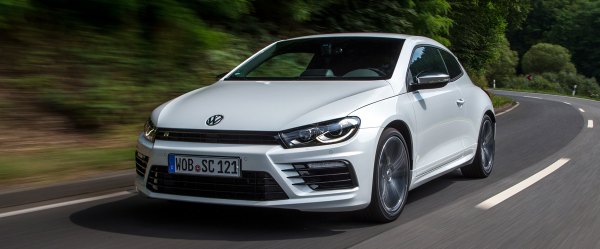
|
Predictably, the 2.0 TSI engine is updated to the latest EA888 unit
with dual-mode injection, 2-stage exhaust valve lift and exhaust
manifold-integrated turbocharger. Power and torque are increased by 20
hp and 51 lbft respectively, though it still trails the Golf
GTI with performance pack. Likewise, the Scirocco R gains another 15 hp
to 280 hp but it is still some 20 hp and 22 lbft shy of Golf R.
Moreover, it
remains front-wheel-drive. The Scirocco R is not short of straight line
pace, but its handling is not as sharp as Golf R, with a less incisive
steering and more terminal understeer. Its tail doesn’t dance according
to throttle, so the sense of man-machine interaction is thin. Nowadays
many hot hatches are more entertaining to drive.
Moreover, the Volkswagen pseudo coupe is overpriced for what it
delivers. BMW M135i and M235i, Audi TT, Renault Megane RS275, Seat Leon
Cupra and Golf R are all better cars and relatively bargains. VW has to
rethink its strategy.
|
Verdict:    |
|
|
|
|
|
|
|
|
|
|
Scirocco
1.4TSI Twincharger
|
2008
|
| Front-engined,
FWD |
| Steel monocoque |
| Mainly steel |
| 4256 / 1810 / 1400 mm |
| 2578 mm |
Inline-4
|
| 1390 cc |
DOHC 16 valves
|
Turbo + supercharger
|
DI
|
160 hp / 6000 rpm
|
177 lbft / 1750-4500 rpm
|
7-speed twin-clutch
|
F: strut
R: multi-link
|
Adaptive damping
|
| 225/45VR17 |
1285 kg
|
| 135 mph (c) |
7.5 (c)
|
-
|
|
Scirocco
2.0TSI
|
2008
|
| Front-engined,
FWD |
| Steel monocoque |
| Mainly steel |
| 4256 / 1810 / 1400 mm |
| 2578 mm |
Inline-4
|
| 1984 cc |
DOHC 16 valves, VVT
|
Turbo, VIM
|
DI
|
200 hp / 5100 rpm
|
207 lbft / 1800-5000 rpm
|
6-speed twin-clutch or
6-speed manual
|
F: strut
R: multi-link
|
Adaptive damping
|
| 225/45VR17 |
1318 kg (DSG) / 1298 kg (6M)
|
| 145 mph (c) |
DSG: 6.7 (c)
6M: 6.7*
|
6M: 17.0*
|
|
Scirocco
R
|
2009
|
| Front-engined,
FWD |
| Steel monocoque |
| Mainly steel |
| 4264 / 1810 / 1394 mm |
| 2578 mm |
Inline-4
|
| 1984 cc |
DOHC 16 valves, VVT
|
Turbo
|
DI
|
265 hp / 6000 rpm
|
258 lbft / 2500-5000 rpm
|
6-speed twin-clutch or
6-speed manual |
F: strut
R: multi-link
|
Adaptive damping
|
| 235/40ZR18 |
1364 kg (DSG)
|
| 155 mph (limited) |
DSG: 5.5 (c) / 5.2***
6M: 5.8**
|
DSG: 12.5***
6M: 12.8**
|
|
|
|
|
|
Performance
tested by: *Autocar, **Auto Zeitung, ***C&D
|
|
|
|
|
|
|
Scirocco 2.0TSI
|
2014
|
| Front-engined,
FWD |
| Steel monocoque |
| Mainly steel |
| 4256 / 1810 / 1406 mm |
| 2578 mm |
Inline-4
|
| 1984 cc |
DOHC 16 valves, DVVT, VVL
|
Turbo
|
DI
|
220 hp / 4500-6200 rpm
|
258 lbft / 1500-4400 rpm
|
6-speed twin-clutch or
6-speed manual
|
F: strut
R: multi-link
|
Adaptive damping
|
| 235/40R18 |
1319 kg (DSG) / 1294 kg (6M)
|
DSG: 152 mph (c)
6M: 153 mph (c) |
DSG: 6.2 (c)
6M: 6.2 (c)
|
| - |
|
Scirocco R
|
2014
|
| Front-engined,
FWD |
| Steel monocoque |
| Mainly steel |
| 4248 / 1820 / 1398 mm |
| 2578 mm |
Inline-4
|
| 1984 cc |
DOHC 16 valves, DVVT, VVL
|
Turbo
|
DI
|
280 hp / 6000 rpm
|
258 lbft / 2500-5000 rpm
|
6-speed twin-clutch or
6-speed manual |
F: strut
R: multi-link
|
Adaptive damping
|
| 235/40R18 |
1375 kg (DSG) / 1351 kg (6M)
|
155 mph (limited)
|
DSG: 5.2 (c)
6M: 5.4 (c)
|
| - |
|
|
|
|
|
|
Performance tested by: -
|
|
|
|
|
|
|
|
|
Copyright©
1997-2015
by Mark Wan @ AutoZine
|
|